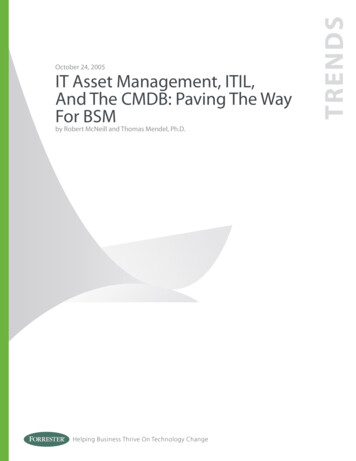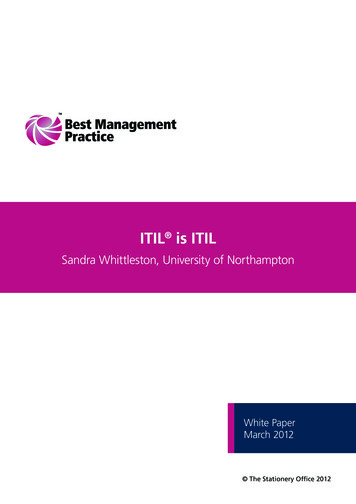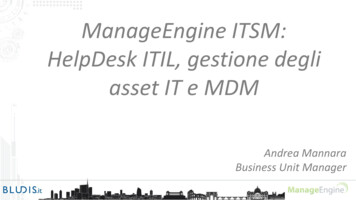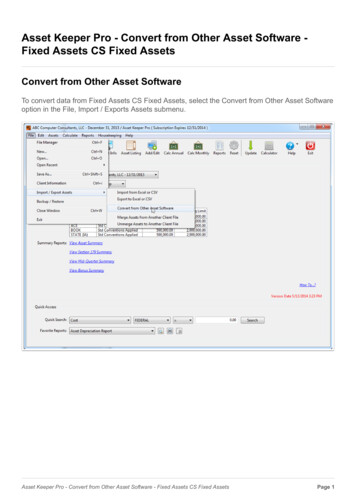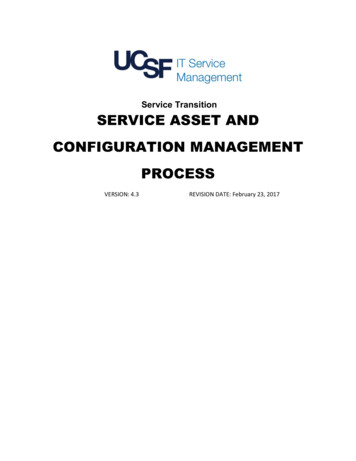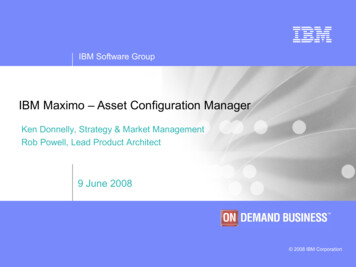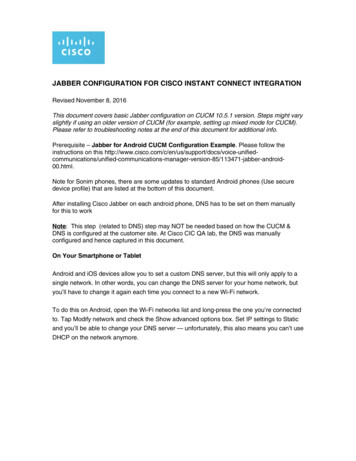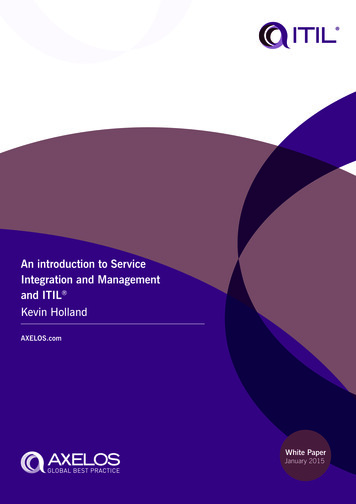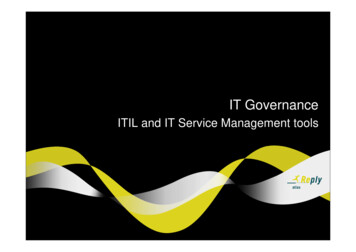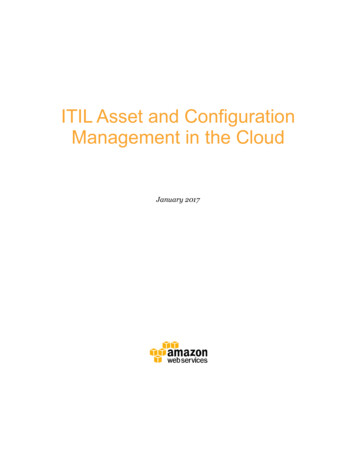
Transcription
ITIL Asset and ConfigurationManagement in the CloudJanuary 2017
2017, Amazon Web Services, Inc. or its affiliates. All rights reserved.NoticesThis document is provided for informational purposes only. It represents AWS’scurrent product offerings and practices as of the date of issue of this document,which are subject to change without notice. Customers are responsible formaking their own independent assessment of the information in this documentand any use of AWS’s products or services, each of which is provided “as is”without warranty of any kind, whether express or implied. This document doesnot create any warranties, representations, contractual commitments,conditions or assurances from AWS, its affiliates, suppliers or licensors. Theresponsibilities and liabilities of AWS to its customers are controlled by AWSagreements, and this document is not part of, nor does it modify, any agreementbetween AWS and its customers.
ContentsIntroduction1What Is ITIL?1AWS Cloud Adoption Framework2Asset and Configuration Management in the Cloud3Asset and Configuration Management and AWS CAF5Impact on Financial Management5Creating a Configuration Management Database6Managing the Configuration Lifecycle in the Cloud8ConclusionContributors910
AbstractCloud initiatives require more than just the right technology. They also must besupported by organizational changes, such as people and process changes. Thispaper is intended for IT service management (ITSM) professionals who aresupporting a hybrid cloud environment that leverages AWS. It outlines bestpractices for asset and configuration management, a key area in the ITInfrastructure Library (ITIL), on the AWS cloud platform.
Amazon Web Services – ITIL Asset and Configuration Management in the CloudIntroductionLeveraging the experiences of enterprise customers who have successfullyintegrated their cloud strategy with their IT Infrastructure Library (ITIL)-basedservice management practices, this paper will cover: Asset and Configuration Management in ITIL AWS Cloud Adoption Framework (AWS CAF) Cloud-specific Asset and Configuration Management best practices likecreating a configuration management databaseWhat Is ITIL?The framework managed by AXELOS Limited defines a commonly used, bestpractice approach to IT service management (ITSM). Although it builds onISO/IEC 20000, which provides a “formal and universal standard fororganizations seeking to have their ITSM capabilities audited and certified,”1ITIL goes one step further to propose operational processes required to deliverthe standard.ITIL is composed of five volumes that describe the ITSM lifecycle, as defined byAXELOS:Service StrategyService DesignService TransitionService OperationContinual ServiceImprovementUnderstands organizational objectives and customer needs.Turns the service strategy into a plan for delivering the businessobjectives.Develops and improves capabilities for introducing new services intosupported environments.Manages services in supported environments.Achieves incremental and large-scale improvements to services.Each volume addresses the capabilities that enterprises must have in place.Asset and Configuration Management is one of the chapters in the ServiceTransition volume. For more information, see the Axelos website.2Page 1
Amazon Web Services – ITIL Asset and Configuration Management in the CloudAWS Cloud Adoption FrameworkAWS CAF is used to help enterprises modernize ITSM practices so that they cantake advantage of the agility, security, and cost benefits afforded by public orhybrid clouds.ITIL and AWS CAF are compatible. Like ITIL, AWS CAF organizes anddescribes all of the activities and processes involved in planning, creating,managing, and supporting modern IT services. It offers practical guidance andcomprehensive guidelines for establishing, developing, and running cloudbased IT capabilities.AWS CAF is built on seven PlatformOperationsSelecting and training IT personnel with appropriate skills, definingand empowering delivery teams with accountabilities and servicelevel agreements.Managing programs and projects to be on time, on target, andwithin budget while keeping risks at acceptable levels.Applying a comprehensive and rigorous method for describing thestructure and behavior for an organization’s security processes,systems, and personnel.Identifying, analyzing, and measuring the effectiveness of ITinvestments.Analyzing, defining, and anticipating demand for and acceptance ofplanned IT capabilities and services.Defining and describing core architectural principles, standards, andpatterns that are required for optimal IT capabilities and services.Transitioning, operating, and optimizing the hybrid IT environment,enabling efficient and automated IT service management.AWS CAF is an important supplement to enterprise ITSM frameworks usedtoday because it provides enterprises with practical operational advice forimplementing and operating ITSM in a cloud-based IT infrastructure. For moreinformation, see AWS Cloud Adoption Framework.3Page 2
Amazon Web Services – ITIL Asset and Configuration Management in the CloudAsset and Configuration Management inthe CloudIn practice, asset and configuration management aligns very closely to otherITIL processes, such as incident management, change management, problemmanagement, or service-level management.ITIL defines an asset as “any resource or capability that could contribute to thedelivery of a service.”Examples of assets include: virtual or physical storage virtual or physical servers a software license undocumented information known to internal team membersITIL defines configuration items as “an asset that needs to be managed in orderto deliver an IT service.” All configuration items are assets, but many assets arenot configuration items. Examples of configuration items include a virtual orphysical server or a software license. Every configuration item should be underthe control of change management.The goals of asset and configuration management are to: Support ITIL processes by providing accurate configuration informationto assist decision making (for example, the authorization of changes, theplanning of releases) and to help resolve incidents and problems faster. Minimize the number of quality and compliance issues caused byincorrect or inaccurate configuration of services and assets. Define and control the components of services and infrastructure andmaintain accurate configuration information on the historical, planned,and current state of the services and infrastructure.The value to business is:Page 3
Amazon Web Services – ITIL Asset and Configuration Management in the Cloud Optimization of the performance of assets improves the performance ofthe service overall. For example, it mitigates risks caused by serviceoutages and failed licensing audits. Asset and configuration management provides an accuraterepresentation of a service, release, or environment, which enables:oBetter planning of changes and releases.oImproved incident and problem resolution.oMeeting service levels and warranties.oBetter adherence to standards and legal and regulatory obligations(fewer non-conformances).oTraceable changes.oThe ability to identify the costs for a service.The following diagram from AXELOS shows there are elements in asset andconfiguration management that directly relate to elements in changemanagement. Asset and configuration management underpins changemanagement. Without it, the business is subject to increased risk anduncertainty.Figure 1: Asset and configuration management in ITILPage 4
Amazon Web Services – ITIL Asset and Configuration Management in the CloudAsset and Configuration Management and AWS CAFAs with most specifications covered in the Service Transition volume of ITIL,asset and configuration management falls into the Cloud Service Managementfunction of the AWS CAF Operations perspective.People and process changes should be supported by a cloud governance forumor Center of Excellence whose role is to use AWS CAF to manage through thetransition. From the perspective of ITSM, your operations should certainly havea seat at the table.As shown in Figure 2, AWS CAF accounts for the management of assets andconfiguration items in a hybrid environment. Information can come from theon-premises environment or any number of cloud providers (private or public).Figure 2: AWS CAF integrationImpact on Financial ManagementOne of the most important aspects of asset management is to ensure data isavailable for these financial management processes: Capitalization and depreciation Software license managementPage 5
Amazon Web Services – ITIL Asset and Configuration Management in the Cloud Compliance requirementsThese activities typically require comprehensive asset lifecycle managementprocesses, which take significant cost and effort. One of the benefits of movingIT to the cloud is that the financial nature of the transaction moves from acapital expenditure (CAPEX) to an operating expenditure (OPEX). You can doaway with the large capital outlays (for example, a server refresh) that requiremonths of planning as well as amortization and depreciation.Creating a Configuration Management DatabaseA configuration management database (CMDB) is used by IT to track andmanage its resources. The CMDB presents a logical model of the enterpriseinfrastructure to give IT more control over the environment and facilitatedecision-making. At a minimum, a CMDB contains the following: Configuration item (CI) records with all associated attributes captured. A relationship model between different CIs. A history of all service impacts in the form of incidents, changes, andproblems.In a traditional IT setup, the goals of establishing a CMDB are met through theprocess of: Discovery tools used to create a record of existing CIs. Comprehensive change management processes to keep track of creationand updates to CIs. Integration of incident and problem management data with impactedCIs with ITSM workflow tools like BMC, Hewlett-Packard, orServiceNow.These processes and tools in turn help organizations better understand the ITenvironment by providing insight into not only the impact of incidents,problems, and changes, but also financial resources, service availability, andcapacity management.There are some challenges to creating a CMDB for cloud resources due to:Page 6
Amazon Web Services – ITIL Asset and Configuration Management in the Cloud The inherent dynamic nature of cloud resource provisioning, whereresources can be created or terminated through predefined businesspolicies or application architecture elements like auto scaling. The difficulty of capturing cloud resources data in a format that can beimported and maintained in a single system of record for all enterpriseCIs. A prevalence of shadow IT organizations that makes information sharingand even manual consolidation of enterprise IT assets and CIs difficult.Configuration Management Inventory for Cloud ResourcesThere are two logical approaches AWS customers can take to create a CMDB forcloud resources:Figure 3: Options for Enterprise CMDB SystemsAWS Config helps customers manage their CIs in the cloud. AWS Configprovides a detailed view of the configuration of AWS resources in an AWSaccount. With AWS Config, customers can do the following: Get a snapshot of all the supported resources associated with an AWSaccount at any point in time. Retrieve the configurations of the resources. Retrieve historical configurations of the resources.Page 7
Amazon Web Services – ITIL Asset and Configuration Management in the Cloud Receive a notification whenever a resource is created, modified, ordeleted. View relationships between resources.This information is important to any IT organization for CI discovery andrecording, change tracking, audit and compliance, and security incidentanalysis. Customers can access this information from the AWS Config consoleor programmatically extract it into their CMDBs.As an example of the potential for integration with legacy systems, ServiceNowthe platform-as-a-service (PaaS) provider of enterprise service managementsoftware, is now integrated with AWS Config. This means ServiceNow users canleverage Option 1 shown in Figure 3.Managing the Configuration Lifecycle in the CloudOne of the goals of service asset and configuration management is to managethe CI lifecycle and track and record all changes. One of the key aspects of thecloud is a much tighter integration of the software and infrastructureconfiguration lifecycles. This section covers aspects of configuration lifecyclemanagement across instance, stacks, and applications: Instance creation templates: Every IT organization has security andcompliance standards for instances introduced into its IT environments.Amazon Machine Images (AMIs) are a robust way of standardizinginstance creation. Users can opt for AWS- or third-party-providedpredefined AMIs or define custom AMIs. If you create AMI templates forinstance provisioning you can define instance configuration andenvironmental add-ins in a predefined and programmatic manner. Atypical custom AMI might prescribe the base OS version and associatedsecurity, monitoring, and configuration management agents. Instance lifecycle management: For every instance or resourcecreated in an IT environment, there are multiple lifecycle managementactivities that must be performed. Some of the standard tasks are patchmanagement, hardening policies, version upgrades, environmentvariable changes, and so on. These activities can be performed manually,but most IT organizations use robust configuration management toolslike Chef, Puppet, and System Center Configuration Manager to performPage 8
Amazon Web Services – ITIL Asset and Configuration Management in the Cloudthese tasks. AWS allows easy integration with these tools to ensure aconsistent enterprise co
ITIL defines configuration items as “an asset that needs to be managed in order to deliver an IT service.” All configuration items are assets, but many assets are not configuration items. Examples of configuration items include a virtual or physical server or a software license. Every configuration item should be under the control of change management. The goals of asset and configuration .
